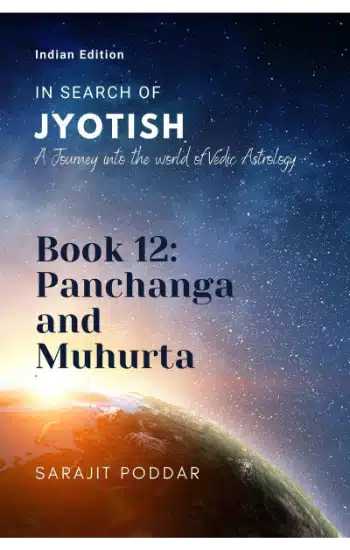Panchanga and Muhurta
Publisher:
| Author:
| Language:
| Format:
Publisher:
Author:
Language:
Format:
₹825 ₹743
Save: 10%
In stock
Ships within:
In stock
| Book Type |
|---|
ISBN:
Page Extent:
THIS IS THE INDIAN EDITION OF THE BOOK After a child is born, the first thing the parents and the family Jyotiṣī looks for is the Pañcāṅga and the condition of Candra. Life is expected to be favourable if the Pañcāṅga elements and their governors are favourable. Pañcāṅga is incredibly useful in Muhūrta and Praśna. While the use of Pañcāṅga in Muhūrta is widely discussed, its usage in Praśna is largely hidden. For classifying time, the Nakṣatras are classified into Kṣipra, Ugra, Miśra, Dhruva, Mṛdu, Tīkṣṇa and Cara. The effects of the Nakṣatras are based on these classes. All have effects following their nomenclatures. The Vāras are classified into Saumya and Krūra. The Yogas (Nitya yogas) are also classified as Śubha and Aśubha. Out of 27 yogas, 8 are considered Aśubha. The four Sthirakaraṇas are avoided for Śubhakarmas. Among the seven Cara, Viṣṭi is avoided. The Tithis are classified into five groups Nandā, Bhadrā, Jayā, Riktā and Purṇa. The Riktā Tithi, 4, 9 and 14 are avoided. Generally, the Oja Tithis, besides the 9th, is favourable. A well selected Muhūrta can help in tilting the balance towards the favourable side, even though the Janmakuṇḍalī has negative yogas. Muhūrta allows us to overcome the blemishes of a Janmakuṇḍalī to an extent. This proves that indications of a Janmakuṇḍalī are not set in stone, and life allows us to make the best use of options granted to us.
THIS IS THE INDIAN EDITION OF THE BOOK After a child is born, the first thing the parents and the family Jyotiṣī looks for is the Pañcāṅga and the condition of Candra. Life is expected to be favourable if the Pañcāṅga elements and their governors are favourable. Pañcāṅga is incredibly useful in Muhūrta and Praśna. While the use of Pañcāṅga in Muhūrta is widely discussed, its usage in Praśna is largely hidden. For classifying time, the Nakṣatras are classified into Kṣipra, Ugra, Miśra, Dhruva, Mṛdu, Tīkṣṇa and Cara. The effects of the Nakṣatras are based on these classes. All have effects following their nomenclatures. The Vāras are classified into Saumya and Krūra. The Yogas (Nitya yogas) are also classified as Śubha and Aśubha. Out of 27 yogas, 8 are considered Aśubha. The four Sthirakaraṇas are avoided for Śubhakarmas. Among the seven Cara, Viṣṭi is avoided. The Tithis are classified into five groups Nandā, Bhadrā, Jayā, Riktā and Purṇa. The Riktā Tithi, 4, 9 and 14 are avoided. Generally, the Oja Tithis, besides the 9th, is favourable. A well selected Muhūrta can help in tilting the balance towards the favourable side, even though the Janmakuṇḍalī has negative yogas. Muhūrta allows us to overcome the blemishes of a Janmakuṇḍalī to an extent. This proves that indications of a Janmakuṇḍalī are not set in stone, and life allows us to make the best use of options granted to us.
About Author
Reviews
There are no reviews yet.
Related products
RELATED PRODUCTS
A Journey into the World of Vedic Astrology- Set Of 33 Books
Save: 20%
How To Judge A Horoscope Vol.1 & Vol. 2
Save: 30%
The Karakatvas A Journey into the World of Vedic Astrology
Save: 10%




Reviews
There are no reviews yet.